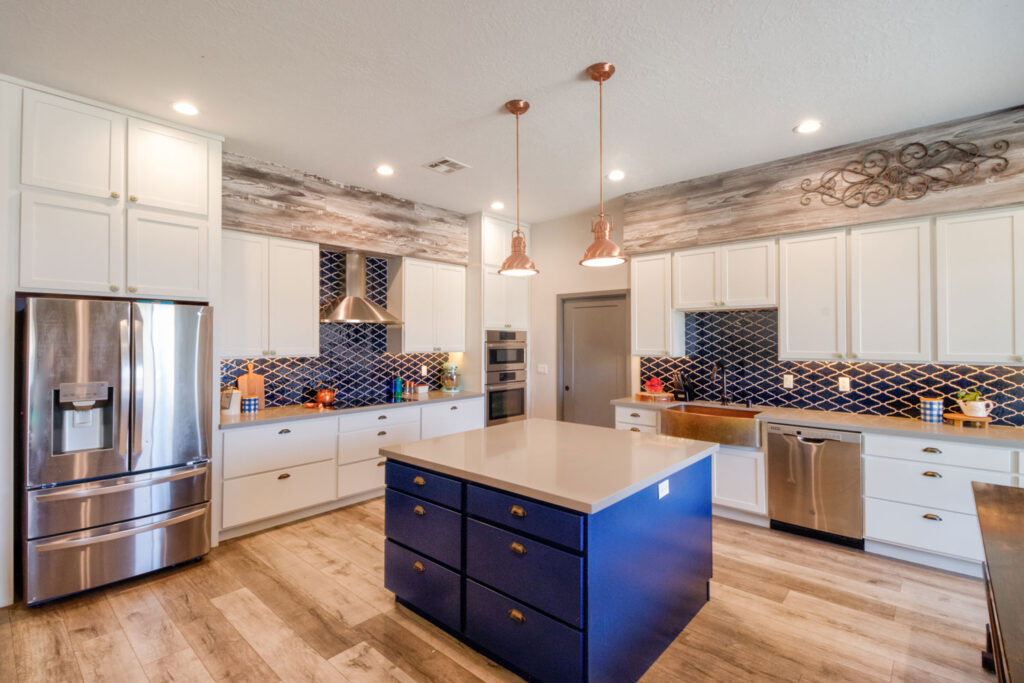As a Designer and an owner of a flooring/remodeling business I’ve helped countless clients transform their kitchens, bathrooms and homes. Plus, as a homeowner and mother of 3 rambunctious kids and 2 furr-babies let’s just say I’ve been there so… Yeah, I get it. Let’s face it, any large renovation seems daunting, but kitchen renovations are their own special brand of nightmare if you have no idea what you are doing. Thankfully there are things you can do to prepare ahead of time to make a kitchen renovation easier on yourself. I’ve compiled my top 10 Ten Ways To Prepare for a Kitchen Renovation into one list.
1. Remember it’s a process, it’s messy AND it can also be fun and exciting.
For my Interior Design Clients I make a Vision Board before I ever make a purchase, before I order materials
for the project, before any major demo, before anything. I do this for two reasons. One, because I want my
clients to be able to see the end goal right from the beginning. And two, I use it as a tool for focus as I am purchasing and selecting materials for my client. To make a vision board for your kitchen, look for pictures that align with what you want the end result to be. Weed down the pictures until you have a cohesive look that you love. Use clippings and glue them onto cardstock or copy/paste them onto a digital page. Whenever you go shopping or out to an appointment for your renovation take it with you so you can show the contractors what you are wanting.
2. Read all of the contracts BEFORE you sign.
I know this doesn’t sound fun or exciting but I’m telling you that you will thank me later. It took me 2 months to research and write the Customer Purchase Agreement for my business. I went through each line over and over to ensure that every single line was essential for our customers. I didn’t want to include anything that I didn’t absolutely have to. I didn’t want my customers to have to waste their time. Let me just tell you, as a highly creative person, contracts are excessively boring to me! So I have zero desire to force one on anyone unless it is absolutely necessary. Here’s the thing about contracts though. It protects BOTH you and the contractor. It establishes clear expectations right from the get go. It says this is what we agree to do and this is what we will not do. My most informed customers are my most satisfied customers because they know exactly what to expect. Those that choose to ignore the contract and our advice are typically more frustrated because of unrealistic expectations.
3. DO NOT begin the demo until ALL of your materials are in.
I’ve seen it before and I’ll likely see it some more: A customer demos their own kitchen, then comes into our showroom wanting an estimate and installation asap because they don’t have a kitchen. Too many folks want to hurry up and start tearing into a space but it won’t do a bit of good and will only add to your overall frustration if materials and finishes get delayed. The demo is typically the easiest and fastest part of the whole renovation. While it may feel good to gut your kitchen that you are sick of looking at, bide you time a little longer. Your patience will pay off when you still have a fully functional kitchen instead of eating take-out for the 3rd month in a row.
4. Stress: accept that you will not be the exception. Your kitchen renovation will be stressful!
I was once that naive person that thought a renovation or new build wouldn’t be that stressful or wouldn’t put stress on my marriage. I was wrong. If you can afford to move somewhere else while your renovation is happening, do it! If you can’t leave for the entire renovation then put some healthy boundaries in place ahead of time and sprinkle in extra grace for all. People underestimate how stressful renovations are, especially when living in one. Get out of the house when it gets too noisy. Invest in noise canceling headphones. Plan a getaway. Take turns going on vacations. There are lots of ways you can escape for a time because kitchen renovations are marathons, not sprints. Divide and conquer: before you head out to make decisions on colors and fixtures, cabinets, counters, etc .. divide up who gets to decide what and put them in order of priority. Give each other a certain number of vetos. Make it fun and playful. Get a strategy for tie breakers. Lean on the advice of the professionals because I’m telling you some days it seems like I do just as much couples mediation as I do design consultations! And if you are thinking “No, that won’t be us”, yes, I’m talking to you too.
5. If you’ve decided you’re sticking it out during renovation, set up a temporary kitchen elsewhere. A table, crock/instapot, microwave, mini fridge, a closet becomes a pantry, etc … Make sure to do this in an area away from the dust and debris that gets pushed up into the air during demo and installations, like a spare bedroom, office, laundry room, or pantry. You will need some spaces in your home where you can escape to. If you fill those spaces with clutter and boxes they will not feel like escapes, they will begin to feel more like prisons. Pack away all of your kitchen wares either in a storage unit, your garage or in a separate bedroom that won’t encroach on your bedroom and living room.
6. Don’t let a contractor tell you how you use your own kitchen.
One of my biggest pet peeves while I was designing and building my current home was when contractors would tell me how I would be using my home. In kitchens there is what is known as “the Golden Triangle”. This is how almost all kitchens are set up with the sink, the fridge and the stove in a triangle formation. It’s supposed to enable homeowners to move about their kitchen with ease. The problem is that I’ve been in way too many kitchens where the refrigerator door, when open, swings into the flow of traffic or there aren’t enough food prep areas for how many people enjoy cooking in the family or appliance doors banging into one another. Often it seems like whoever designed the kitchen was more concerned about the triangle rule than the people who will be using it. So when I was designing my own kitchen I made decisions that were out of the norm. I went with drawers only for my lower cabinets and haven’t looked back once. My “triangle” looks like an elephant is sitting on it; it’s so obtuse it’s almost a line, but it means I don’t have to fight for space while I’m in the kitchen and my kids are grabbing something out of the fridge. I put a soffit above my cabinets so that I wouldn’t have any space to catch dust in between my ceiling and the top of my cabinets. For every single one of these choices I first did my research, but once I had and felt good about it I had to hold my ground because the contractor doing the work tried to talk me out of it. All because it just wasn’t normally done. You know you and your family best. It’s your kitchen. If you know you want something, you’ve done your research and it’s safe to do so and you are willing to pay for the work and materials then stick to what you want. It’s your house. At the end of the day you are the one that has to live with the decision and you are paying a lot of money not to get what you want.
7. Stay organized.
Make a binder or use digital files. Unless you are using a general contractor or interior designer who is handling everything for you, you will be using multiple subcontractors for your kitchen renovation. You will have to become your own general contractor.
8. Know your nomenclature.
The construction world has all kinds of jargon. If you don’t know what a word means on an estimate or a contractor starts talking about moving some pipe and duct with names that don’t make sense to you, ask! Some contractors are better about customer education than others. Ask them to clarify, do your homework and educate yourself. Remember, when you are well informed the lower your stress will be, the more you know what to expect, and the better the overall outcomes will be.
9. Know your timeline.
Certain materials have to go into a kitchen before other materials. For example: LVP floors have to be installed before baseboards. Otherwise, if baseboards are installed and painted, the flooring installers have to take off the baseboards, install the flooring then reinstall the baseboards. This also means potential damage to your new baseboards that is not covered in the cost of your flooring installation. It means paint and caulking touch ups that are the responsibility of the customer. Knowing this you can schedule the flooring installers to come in and install the floor and new baseboards, followed by the painters who will then caulk and paint the baseboards. So, where one timeline can be incredibly aggravating and a waste of time and money for all parties involved, the other timeline saves time, money and lots of headaches for everyone.
10. Expect Murphy: Murphy’s Law “Anything that can go wrong will go wrong.”
Murphy is alive and well in the construction world.. Just expect him to rear his ugly head at some point along the way. Remember that Estimates, simply put, are an approximate prediction of the total cost of the tasks, time, and resources required to deliver a project’s scope of work.That means that once walls, cabinets, floors, pipes, electrical and appliances are torn out during demo any number of issues and problems can be found. And in my experience, wherever there is water and electricity, Murphy may be lurking. Prepare for the worst, and hope for the best. Plan on the project budget costing about 30% more than what you originally planned. Plan on the project time budget taking longer than expected. Most contractors give tentative installation dates for a reason. Freight issues may arise, broken materials arrive at the job site and have to be returned and wait for new material, problems under substructures, changes in initial plans and any number of factors play into why you may get a visit from Murphy. So just plan for him and when he shows up it won’t shock you. You’ll be ready.
All this being said, go back to #1 if you forget why you are doing it. It’s supposed to be fun… and messy. It’s like running that marathon. It’s exciting at first, it feels like it will never end when you’re in the thick of it but then crossing the finish line is pure satisfaction, not to mention you are glad it’s over and you need to recover.

























